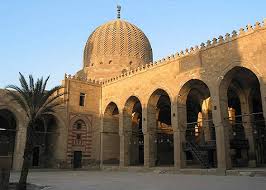
The Complex of Farag Ibn Barquq lies in El-Sultan Ahmed Street few meters away from the Northern Cemetery. This magnificent complex was initiated by Sultan Barquq who was the first MAmluk Sultan to be buried next to the Sufi Shaykhs in the Northern Cemetery, and then completed by his successor Farag. Sultan Farag ruled Egypt for about 13 years after the death of his father and his reign was a period of turmoil and conflicts and ended with his assassination in Syria. He was brought back to Egypt to be buried in his tomb in this complex. This complex is regarded as a typical example for the sumptuous style of the Mamluk period. This is clear in the twin Sabil-Kuttab whose porch can be seen over the entrance and was used as a place for studying Quran and prophetic instructions. In addition to the are magnificent twin minarets, from their top one can enjoy a magnificent overview of the surrounding area that involves many charming monumental places including the Heliopolis, the complexes of Barsbay, and Qaytbay and the Citadel.
The original entrance of this complex was placed in the southwest corner and preceded by a block of stone that date back to the Pharaonic period. After the main entrance, there is an arched vestibule with some openings in the ceiling for illumination and ventilation. The interior plan opens with a central courtyard supported with arcades which can be regarded as an imitation of the style of the mosque. There is also an arcaded sanctuary aisle surmounted by shallow domes and in its far end exists a Dikka or a platform that was used for reciting holy Quran. Of special interest among the items placed inside the complex are the simply decorated Mihrab and the stone Minbar with attractive carvings that date back to 1483. Through some stair steps in one of the courtyard's corner, one can go up to the second floor that was dedicated to the residence of the Sufi Dervishes or mystics, in addition to some passageways and other places. These lodgings prove that the building was mainly established as a Khanqah for the Sufis but its style is different from the typical Mamluk style.
The tomb of Sultan Farag that is attached to this complex is considered one of the greatest remaining funerary structures in the northern cemetery. In the northern corner stands a chamber that involves the large cenotaph of Sultan Farag, in addition to other smaller ones for his brother and successor Abd El-Aziz and another cenotaph whose owner is unknown. In the southern corner appears another chamber that involves the cenotaphs of some female members including Sultan Barquq's grand daughter, Sultan Farag's daughter, and mother in addition to some of their faithful servants. The beauty of the entrance of these funerary chambers is accentuated by the wooden screens with handsome geometric patterns and the twin dome that support them. These stone domes are distinguished by their size, the thickness of their transition zone and their concave and convex moldings that were imitated in other mausoleums later. The design and style of decoration of these tombs represent a shift in the Mamluk ones. The interior plan of the tombs is beautified with shallow stone niches and the interior part of the dome is beautifully inlaid with harmoniously colored marble patterns. The most remarkable feature of this structure is the one ever two windows over the arched openings. Hereabouts appears the Mausoleum of Anas the father of Sultan Barquq that was once linked with the funerary chamber of Barquq through an arcade that disappeared now.
